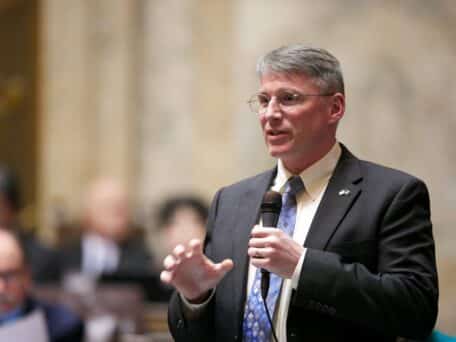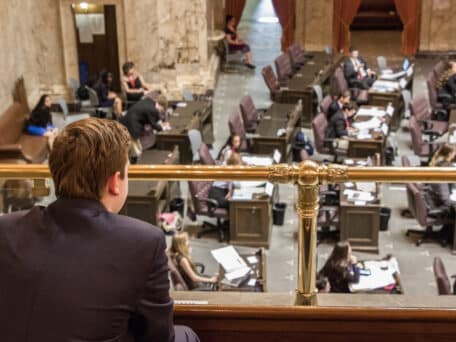This week’s Newsmaker Interview is with King County Councilmember Reagan Dunn who has been at the forefront of the region’s response to the coronavirus outbreak. Dunn shares with us his thoughts about King County being the initial national COVID-19 outbreak location and how we can recover from this sudden attack on our economy. The councilmember also shares his thoughts about his Family Reunification program which helps homeless individuals return to their families.
1) You have been very active regarding King County’s response to the coronavirus outbreak. How do you think the county has responded? What has it done well and where can there be improvements?
King County found itself at the epicenter of a national crisis when the COVID-19 outbreak occurred at Life Care Center in Kirkland. I appreciate that from the time the virus first appeared here, King County took it very seriously and our response was immediate. I was personally very deeply concerned about the deadly potential of COVID-19—and I remain concerned today. We are thankfully moving through the pandemic and seeing signs of improvement. To his credit, I am convinced that the Executive’s local social distancing orders helped contain the virus and saved thousands of lives.
Following the initial outbreak, we the King County Council approved $48.3 million in emergency funding to support our Public Health response. I can’t overstate my appreciation for the Public Health employees who are on the frontlines, feeling the brunt of problems such as a shortage of testing supplies. This is definitely not business as usual—right now the Council is only taking up actions that are either completely necessary or directly related to COVID-19. The leadership team, which I’m a part of, is in near constant communication. I think there is a broad recognition that there is no time for partisan gridlock. If anything could be improved, I think it would be communication. Due to emergency powers, a lot of decisions are being made unilaterally for the sake of efficiency, and it can feel like the left hand doesn’t know what the right hand is doing.
Looking back, I have no regrets that we should have done more to slow the outbreak—which was my driving motivation. Looking forward, my focus is on not losing the public health gains we sacrificed so much for and helping our region recover economically. There’s a serious danger that re-opening too quickly would put us at risk of a second wave of COVID-19. This is at the forefront of my mind right now.
2) You introduced legislation that would create the CuRE (Coronavirus Recovery Economic) Task Force to plan for economic recovery. What specifically are you hoping to have this group accomplish and what will be its timeline?
I first proposed the CuRE Task Force a couple weeks ago knowing that soon, local leaders would need to shift our perspective from slowing the spread of the COVID-19 pandemic to re-opening and revitalizing our economy. I wanted to make sure that when we started developing a plan of action, the perspectives of businesses and industries were heard as well. My vision is that representatives from a broad group of business, government, and industry leaders will be a part of the economic recovery conversation. We all want to help the economy bounce back, so let’s work together.
3) Recently you announced that you were working with Renton Mayor to attract companies working on COVID-19 vaccine. Can you give us more of the details and an update on how this is going?
Renton Mayor Armondo Pavone and I see an opportunity to try and attract pharmaceutical companies to site their COVID-19 vaccine facilities in Renton. If we’re successful, such a facility would be a huge economic boost to our region. Renton has a lot of things that make it a great location for vaccine manufacturing—such as robust manufacturing, tech, and medical sectors, its proximity to airports and freeways, the educated workforce, and, importantly, pro-business city leadership.
The Renton City Council approved legislation last Monday approving the hiring of a consultant to begin talks with companies that are looking for a place to land their manufacturing facilities. I myself reached out to Johnson & Johnson to make sure they’re aware of our desire to do business, as they are looking at building two new facilities. Time will tell if our efforts are successful, but we truly believe Renton could be a major player in bringing a lifesaving vaccine to the world.
4) Prior to the coronavirus outbreak you had said you expected the county to vote on at least six tax increases this year. What do you think will be the county’s reaction be to the outbreak? Will they impose more taxes on its citizens to pay for more government programs or will they give citizen a financial break as families try to stabilize their finances?
As of the beginning of this year, I was anticipating six taxes to be proposed in King County this year: a County-wide head tax, a King County Library System levy, CAWA (Cultural Arts Washington) levy, an unincorporated roads Levy, a transit levy, and the Harborview Bond. Of these six taxes, only two are still in play.
The state legislature rejected legislation that would have authorized a County-wide head tax, but a similar Seattle-only tax is being considered at the Seattle City Council. I expect this fight won’t go away soon. As for the others, County leadership wisely chose to put the unincorporated roads and transit levies on hold, realizing that it’s difficult to ask taxpayers for more money during a pandemic. Cultural Arts Washington and King County’s 4Culture have expressed similar hesitancy to push for more funding for the arts at this time.
That leaves two tax increases that may still come down the pipeline. The first is the King County Library System levy. The KCLS Board, which is an independent entity, hasn’t taken any action to withdraw their ballot measure yet, leaving it to appear on the November ballot.
The second tax increase to watch would be the Harborview bond, which is still under consideration by the King County Council. This levy would cover upgrades to our outdated Harborview Medical Center campus. Though I’ve voted against tax increases more than any other King County Councilmember, I believe the Harborview bond measure is worth consideration. Harborview is the only Level 1 trauma center in the Pacific Northwest and is widely recognized as one of the best medical facilities in the world. I’m interested in maintaining that, especially after seeing the strain on our healthcare system during the COVID-19 pandemic. This bond would allow us to increase the number of single occupancy rooms and respite beds, which could prove invaluable in a future health crisis. If one tax is worth putting to the people, it’s this one.
5) Before the outbreak occurred, you made news by passing legislation to help homeless individuals buy a bus ticket to return home. Can you give us an update on this program?
It was a real uphill battle to get the Council to approve my Family Reunification plan. A lot of folks at the County were sensitive to the optics of purchasing tickets for a homeless person, and it took a lot of long conversations to get people to see it as a leg up for people who need it, not just a ticket out. It came down to this: if we could help a struggling individual reach not only dependable shelter, but a support network of people that care for them, and in a cost-effective way too, why wouldn’t we?
In the end, I was able to gain the support of a majority of my Council colleagues, and the family reunification strategy has been integrated into DCHS’s homelessness response. Right now, if a person who is homeless seeks help at a Regional Access Point, they should be presented with the option to receive a complimentary bus ticket. I’ve actually had many homeless people call my office directly asking how they could get a ticket, and my staff have been connecting them with DCHS—so there’s an obvious interest in the service.
6) You represent many constituents who live in the rural communities of the county. Recently we have seen the county allow roads to return to gravel. Are rural constituents receiving the attention they need from the county?
Generally speaking, it is a constant effort to get County resources directed to rural communities. In some ways, how this happens is obvious. For example, rural areas by nature will never have the public transportation that urban areas have—and sometimes, this is preferred by folks who don’t want buses rolling through their neighborhood. However, a main focus of mine is trying to help bring County funding to the community service organizations—such as food banks, senior centers, and youth sports teams—that are so critical to rural communities that don’t have the urban amenities that Seattle has. Part of my job is to make sure these groups aren’t forgotten and overlooked.
Now, County roads funding is actually a more complex issue than it appears on the surface because of the County’s funding structure. For years, County funding for unincorporated roads has been dwindling because of structural issues with the Growth Management Act (GMA), annexations, and limited funding avenues afforded to the county by the state. By state law, funding for unincorporated roads is limited to property tax on unincorporated residents. In a different time, this policy may have made sense. However, as the GMA continues to promote urban density, and as more and more of the suburban unincorporated areas are annexed into cities, the tax base for unincorporated roads has shrunk.
At the same time, the nature of unincorporated roads has changed. Even though unincorporated King County residents are footing the full bill for unincorporated roads, the roads are increasingly being used by commuters from one city to another, or by urban residents travelling into rural areas for hiking or other recreation. The problem is, even if the County maxed out roads tax levies, we would only be able to maintain the current levels of service, and unless the state acts to change the County’s funding structure, the tax burden would fall solely to residents of unincorporated areas. It’s a classic “between a rock and a hard place” situation.




